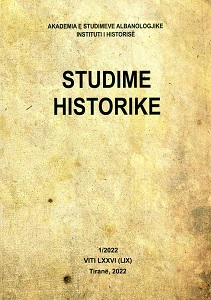IDEOLOGJIA, POLITIKA DHE HISTORIA: RASTI I KRYENGRITJES SË SHQIPËRISË SË MESME (1914-1915)
IDEOLOGY, POLITICS, AND HISTORY: THE CASE OF CENTRAL ALBANIA’S UPRISING (1914-1915)
Author(s): Artan R. HoxhaSubject(s): Cultural history, Governance, Social history, Pre-WW I & WW I (1900 -1919), Geopolitics
Published by: Qendra e Studimeve Albanologjike
Keywords: Enver Hoxha; Uprising of Central Albania; peasantry; the proletariat; the bourgeoisie; the feudal lords; historical materialism; ideology; politics; Karl Marx; Marxism-Leninism;
Summary/Abstract: This article explores the use (and misuse) of history in communist Albania. History is linked through many threads with politics and its writing, and regardless of the efforts of many historians to depoliticize their work, continues still to be largely a political act. In this sense, the writing of history during communism is not an exception from a general rule. However, as it is the case in dictatorships, the politics and ideology are not merely generated by the historians themselves but are dictated from the political authorities, sometimes even from the leadership. This was the case in communist Albania, and the revolt that took place in Central Albania in 1914-1915 was a case in point. It was Enver Hoxha himself who laid down the main thesis on how the historians had to analyze this revolt. Indeed, the Albanian Stalinist leader considered history as a powerful tool to legitimize his power and the communist takeover in Albania at the end of World War Two. Merging Marxist-Leninist historical model with nationalism E. Hoxha constructed a narrative that aimed at proving that the establishment of the Albanian Communist Party (after 1948 renamed Albanian Labor Party) and its coming to power was not an accident but rather the fulfillment of the logic of history. For this reason, E. Hoxha wanted to prove that there were historical antecedents to the communist-led resistance of WWII. The Revolt of Central Albania that took place in 1914-1915 was one of those key revolutionary moments. This uprising had a pronounced Islamic tint and its targets became Prince Wilhelm Wied, the Prussian noble that the European Powers appointed at the head of the newly founded Albania, and the Albanian landed nobility, which supported the prince. According to the ALP’s leader, the uprising of 1914-1915 was a peasants movement against their landlords, where class struggle and liberation war merged into one single denominator. Comparing this insurrection with the German Peasant Revolt of the XVI century, Enver Hoxha argued that behind the religious slogans hid a political program and Islam provided the peasants with a language to expose their goals. This rebellion, he argued, failed because the bourgeoisie, which entered in an alliance with the landed aristocracy, did not support the peasants. The true liberation of the peasantry would come during the WWII, when it entered in alliance with the working class. In this way, E. Hoxha constructed for Albania a replica of the Soviet unilinear and universal historical narrative disregarding the local dynamics and particularities.
Journal: Studime Historike
- Issue Year: 2022
- Issue No: 01
- Page Range: 99-123
- Page Count: 25
- Language: Albanian
- Content File-PDF

